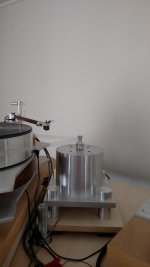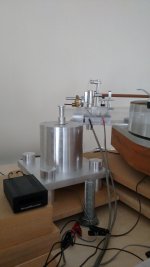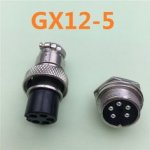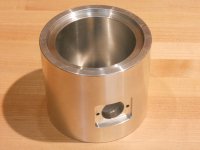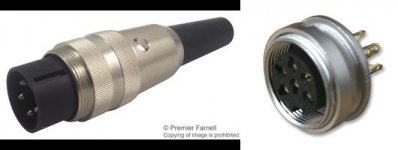Here are two pulley's one on a large Bldc motor and the other on a papst. Both driven with Bills sg4 controllers. Notice the road runner rpm gauge. Glad I got one when it was available.
Enjoy the ride
Tom
Enjoy the ride
Tom
Attachments
Thanks Ralph...I was hoping that was the answer, since Bill stated he accomplished it through software I figured I would ask.
After a couple of weeks of working here and there I managed to finally work out the kinks in my motor housing. I had started it while waiting for the amp boards. It began life as a piece of 1/2" wall 4" diameter 6061 pipe I got at my local metal yards "Discount Barn" and some 5/16" plate scrap I had around.
I still have to finish up the pulley before I move on to the controller and amp. Figured I'd post a pic for fun. I'll probably post more of the fabrication process once I find time to start a thread about refurbishing/modifying my HW19.
I was just wondering if you are going to use an over the counter XLR cable or areyou making your own with a little heavier wire?
I planned on building my own harness. I have a bunch of XLR parts I picked up recently when the local Radio Shack liquidated. I was going to match the gauge of the wiring on the motor. The harness will probably be made from some decent surplus wire I got from Apex Jr. I'll sheath it in expandable PET braided sleeve and make the ends pretty with shrink tubing if needed.
I will make my request as a member of the pro audio world here, please do NOT use a 3 pin xlr for power at any time. We have moved to using any of the other pin configurations (4 and up) for power connections and reserving 3 pin for audio *only*.
I know, its personal use, but.... At one time we had tons of people using 3 pin xlr connectors for ac power as well as audio, now lets see, wall socket, mic, poof, oops
Cheers
Alan
I know, its personal use, but.... At one time we had tons of people using 3 pin xlr connectors for ac power as well as audio, now lets see, wall socket, mic, poof, oops
Cheers
Alan
Last edited:
Hmmm....The drive signal to the motor is ~8.5VRMS; more than a mic/line level but still "low voltage". It is certainly appropriate to draw attention to practices that violate established electrical codes (or common sense), but unless XLR connectors are universally understood to be line level interfaces (and I don't know if they are), I don't see a problem with using them in this instance. I personally used a 3 pin miniature version of the mic connectors that ralphfcooke proposed and the voltages and currents involved certainly are within the limits of those type of connectors. Maybe it would be prudent to label the connector(s) with the actual voltage/current/power ratings that would be expected in this case, just to prevent a misunderstanding from occurring?
There was several reasons why I used an XLR connection for this application. As Bill mentioned, it appeared to meet the expected voltage/current requirements, it had 3 conductors and I had them on hand.
I had a couple of 4 conductor mic connectors on hand similar to the one bill used, but the machining process to mount the XLR was easier.
In contrast to the mic connector having a single nut around its threaded diameter which would not easily seat on the the inner curved surface of the housing which would require extensively reducing the housing wall thickness and a shaped recess, the XLR receptacle has two screws holding it to the motor housing via its flat square mounting plate.
The XLR receptacle only required a few simple passes on my milling machine to create a symmetrical flat area on the outside of the curved housing. I was then able to bore a hole on center and drill/thread the two mounting holes.
I have no other implementation of XLR connectors in my system as I have no balanced equipment, nor do I have any intention of integrating/building any balanced equipment and I am the only person that connects or operates any of this equipment.
That being said, I would never use the XLR connectors like this in any other environment.
I had a couple of 4 conductor mic connectors on hand similar to the one bill used, but the machining process to mount the XLR was easier.
In contrast to the mic connector having a single nut around its threaded diameter which would not easily seat on the the inner curved surface of the housing which would require extensively reducing the housing wall thickness and a shaped recess, the XLR receptacle has two screws holding it to the motor housing via its flat square mounting plate.
The XLR receptacle only required a few simple passes on my milling machine to create a symmetrical flat area on the outside of the curved housing. I was then able to bore a hole on center and drill/thread the two mounting holes.
I have no other implementation of XLR connectors in my system as I have no balanced equipment, nor do I have any intention of integrating/building any balanced equipment and I am the only person that connects or operates any of this equipment.
That being said, I would never use the XLR connectors like this in any other environment.
@chromenuts-
I did a similar operation with the miniature mic connectors (note: these are smaller diameter than the standard ones). I had a flat area milled in the face of the housing, drilled an oversized hole in the middle of the flat spot, mounted the mic connector onto an 0.062" sheet of aluminum, and screwed the plate onto the opening in the housing.
I did a similar operation with the miniature mic connectors (note: these are smaller diameter than the standard ones). I had a flat area milled in the face of the housing, drilled an oversized hole in the middle of the flat spot, mounted the mic connector onto an 0.062" sheet of aluminum, and screwed the plate onto the opening in the housing.
Attachments
This is the latest interation of the 3 phase BLDC motor controller. I was able to apply a few things I learned doing the SG4 to this design, and eliminate some (expensive) hardware and freed up some real estate in the process. I was able to combine the 25W amp with the 3 phase controller onto one small PCB that fits in the Eagle controller extrusion. The whole power supply is about the size of a pack of cigarettes, but drives a 12W motor with 2-3x the torque of a Hurst 300 RPM motor. The motor is much quieter than an AC synch motor as there is zero cogging and the bearings are much more precise. The controller can drive the motor from 1Hz (30 RPM motor, 1.667 RPM platter) to 64Hz (1920 RPM motor, 106.667 RPM platter), so I can do 33/45/78 RPM with one pulley, loads of torque and no burn out on the belt at all.😀
The circuit is essentially the same as the previous version, except that I am developing all 3 phases in the uP. It still has the same frequency resolution as the previous version and still accepts feedback from the RoadRunner tach so it holds the platter speed to within ±0.005 RPM. I was also able to get the BOM cost below $75.
I need to recalibrate the frequency/voltage/phase function which should only take an afternoon to do. After that, I plan on measuring the torque at various speeds and compare the results against the Hurst motors. I built a jig that will hold either motor and read the torque out directly in oz-in.
Hi,
Where can I get a controller like that? I too, have a Roadrunner, and it would be great if I can use the output of the tachymeter to dialog with a motor controller and keep the speed perfectly steady.
Please let me know.
Best Regards
G. Riolo
Hi,
Where can I get a controller like that? I too, have a Roadrunner, and it would be great if I can use the output of the tachymeter to dialog with a motor controller and keep the speed perfectly steady.
Please let me know.
Best Regards
G. Riolo
You can not do that with the SG4 and the roadrunner, just monitor the speed.
RE: 3-pin XLR for non-audio use:
My father always gave me plenty of leeway to do what I wanted when I wanted, but there were, of course, limits, and consequences.
To avoid the consequences, (and those consequences were not necessarily something he had control over or instituted) every once in a while he would gently proclaim:
"It would be better if you didn't".
"Better" was always completely undefined ... could mean anything from needing five more minutes of driving to get somewhere, to annoying the girlfriend, to avoiding a sentence of 80 years to life. (Well, maybe he would define that last one, but you get the idea). And he would let me find out for myself what "not better" meant, if I chose to dismiss his advice. Life lessons.
So, go ahead, use the 3-pin XLR for power, but it would be better if you didn't.
🙂
My father always gave me plenty of leeway to do what I wanted when I wanted, but there were, of course, limits, and consequences.
To avoid the consequences, (and those consequences were not necessarily something he had control over or instituted) every once in a while he would gently proclaim:
"It would be better if you didn't".
"Better" was always completely undefined ... could mean anything from needing five more minutes of driving to get somewhere, to annoying the girlfriend, to avoiding a sentence of 80 years to life. (Well, maybe he would define that last one, but you get the idea). And he would let me find out for myself what "not better" meant, if I chose to dismiss his advice. Life lessons.
So, go ahead, use the 3-pin XLR for power, but it would be better if you didn't.
🙂
Last edited:
Would a multi-pin DIN specification connector (panel mount & corresponding plug)be suited for speed controller output to motor (e.g. 4 wire 2 phase connection to motor). Its rated at 250VAC. I'm thinking of this product for reasons that I can easily order and buy this product.
Product – Lumberg
Product – Lumberg
Attachments
Last edited:
I have been happily using this motor and pyramids controller for a while now. I have a slight issue that doesn't seem to affect performance in any audible way but bothers me to no end. My motor is slightly noisy. If I spin the platter by hand with the belt attached and with the controller not turned on I get absolutely silent running. As soon as I turn the motor on I get some small noise that sounds like something is rubbing. I thought it might be the wave washer that held the shaft in place or the bearings but what is stumping me is that the sound only happens when voltage is applied. When simply spinning the whole thing by hand it is dead silent, any help would be appreciated.
My motor is a bit noisy too.
I have ordered some ceramic bearings that I hope I can fit in and see if things get better.
I have ordered some ceramic bearings that I hope I can fit in and see if things get better.
My motor is a bit noisy too.
I have ordered some ceramic bearings that I hope I can fit in and see if things get better.
I have been contemplating the same, did you buy hybrid bearings? ceramic balls & steel races, coming from a skateboarding background this seems to be the best combination. Keep us updated I am curious how you are going to get the old ones off and new on.
I still am confused though seeing as how mine is silent if I simply spin it without power which is leading me away from the bearings? Curious about anyone else experience.
Just spinned the platter by hand, and the noise at the same rpm, is about the same as with the motor on.
I really don' t know how to get the bearings out, will see what I will do when i have the replacements at hand.
I really don' t know how to get the bearings out, will see what I will do when i have the replacements at hand.
I have been happily using this motor and pyramids controller for a while now. I have a slight issue that doesn't seem to affect performance in any audible way but bothers me to no end. My motor is slightly noisy. .
I'm running the BLWR currently and have had the same issue. I replaced the bearings with these. Amazon.com: 5x16x5mm Hybrid Ceramic Brushless Motor Ball Bearings (2): Industrial & Scientific
Unfortunately, they didn't make any difference in the end. I even took the seals off the bearings and added grease in an attempt to quiet them. I'm looking at these bushings as suggested in the thread. I'll have to make adapters & slip them into the motor end caps.
https://www.igus.co.uk/product/5
I really don' t know how to get the bearings out, will see what I will do when i have the replacements at hand.
The bearings pop off easily but you will want to fashion a puller. A simple one from a 1' square tube with a small screw will do the trick.
http://4.bp.blogspot.com/-p2vhorH19Jg/UAOaESKsiMI/AAAAAAAACQE/CLMCjz4vo0E/s1600/P1100796.jpg
Cheers,
Gregory
Did you guys play with lower run voltage. The sg4 has that feature. I do not have the motors you guys are running but in all the motors I played with the noise was reduced with lower voltage.
That being said you might like the sound of the music better with the higher voltage. Easy enough to experiment and see what you like.
Enjoy the ride
Tom
That being said you might like the sound of the music better with the higher voltage. Easy enough to experiment and see what you like.
Enjoy the ride
Tom
There are many BLDC motors and controllers on Aliexpress. I have purchased several and they work great, but I have not used them for a TT. I would think at 1500 rpm, cogging of the motor would be a non-issue?
- Home
- Source & Line
- Analogue Source
- 3 Phase BLDC motor for turntable use?
